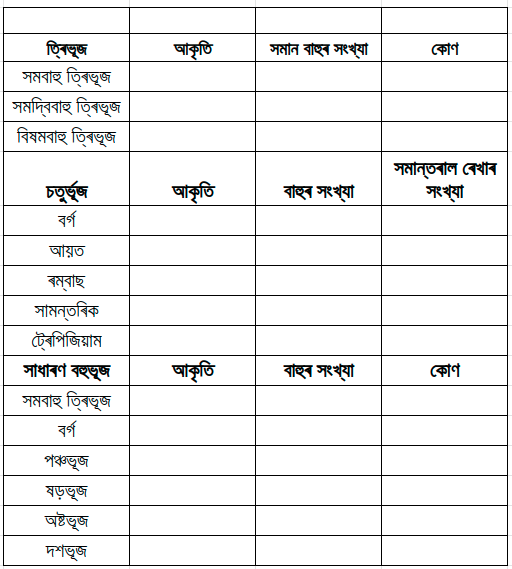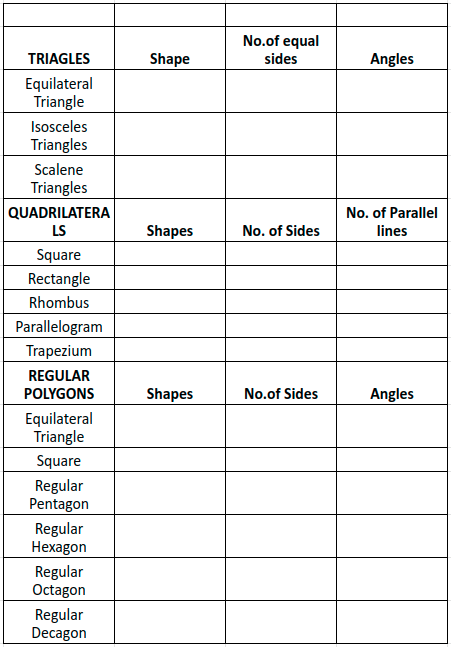শিক্ষণীয় উদ্দেশ্য:
- ছাত্ৰ-ছাত্ৰীয়ে মৌলিক জ্যামিতিক আকৃতি আৰু ইয়াৰ বৈশিষ্ট্যসমূহৰ বিষয়ে জ্ঞান লাভ কৰিব।
- তেওঁলোকে চৌপাশৰ জ্যামিতিক আকাৰসমূহ আৰু ইয়াৰ প্ৰয়োগৰ বিষয়ে জ্ঞান লাভ কৰিব।
| ১ম দিন
সময়: ১০ মিনিট ক্ৰিয়াকলাপ: সময়: ৩০ মিনিট ক্ৰিয়াকলাপ: • ছাত্ৰ-ছাত্ৰীয়ে কাঠি/জুইশলা কাঠিৰে বিভিন্ন জ্যামিতিক আকৃতি বনাব আৰু বহীত একেটা চিত্ৰ আঁকি নামৰ লগতে তাৰ ধৰ্ম লিখিব। তাৰ পিছত তেওঁলোকে শিক্ষক/অভিভাৱকক দেখাব। • ছাত্ৰ-ছাত্ৰীয়ে তেওঁলোকে বনোৱা আকৃতিসমূহৰ লগত মিল থকা চৌপাশৰ বিভিন্ন বস্তু বিচাৰি উলিয়াই টোকাবহীত নাম লিখিব আৰু শিক্ষক/অভিভাৱকক দেখাব। ছাত্ৰ-ছাত্ৰীক কুণ্ডলীৰ আকাৰৰ (মহ খেদিবলৈ ব্যৱহাৰ কৰা কুণ্ডলীৰ নিচিনা, Mosquito coil) আৰু খাৰুৰ আকাৰৰ বস্তু সংগ্ৰহ কৰিবলৈ কোৱা হ’ব। কাগজত তাৰ চিত্ৰ অংকন কৰি দুয়োটা আকাৰৰ মাজত পাৰ্থক্য লিখিব কোৱা হ’ব। এনেধৰণৰ আকাৰৰ আন বস্তু নিৰীক্ষণ কৰি শিক্ষকৰ লগত ভাৱ বিনিময় কৰিব। প্ৰয়োজনীয় সমল লিংক: এই লিংকটোৰ সহায়ত জ্যামিতিৰ মৌলিক ধাৰণা লাভ কৰিব পাঠ্যপুথি (পৃষ্ঠা নং- 57) পাঠ্যপুথি (পৃষ্ঠা নং- 63) পাঠ্যপুথি (পৃষ্ঠা নং-61) পাঠ্যপুথি (পৃষ্ঠা নং- 71) |
| ২য় দিন
সময়: ৩০ মিনিট মূল্যায়ণ: • ছাত্ৰ-ছাত্ৰীয়ে তেওঁলোকৰ চৌপাশৰ পৰা কোণৰ আকাৰৰ বস্তু বিচাৰি, সেই একেখিনি বস্তুৰ চিত্ৰ অংকন কৰি বা ফটো উঠাই শিক্ষকৈ পঠিয়াব। (যেনে- ঘড়ী, আধা খোলা দুৱাৰ, মেজৰ দাঁতিকাষ ইত্যাদি) • তেওঁলোকে পিছত দৈনন্দিন জীৱনত কোণৰ ব্যৱহাৰিক দিশৰ বিষয়ে লিখিব। প্ৰয়োজনীয় সমল লিংক: পাঠ্যপুথি (পৃষ্ঠা নং-68,69) • ছাত্ৰ-ছাত্ৰীয়ে জ্যামিতিক আকাৰ আৰু ৰেখাৰ চিত্ৰ আঁকি শিক্ষকক দেখুৱাব • ছাত্ৰ-ছাত্ৰীয়ে তলৰ তালিকাখন সম্পূৰ্ণ কৰি তেওঁলোকৰ শিক্ষক/অভিভাৱকক দেখুৱাব |
Click here to download the lesson plan
প্ৰস্তুতকৰ্তা: ছাইফুল ইছলাম, আলিটাঙনী ছিনিয়ৰ মাদ্ৰাছা, নগাঁও, অসম
সম্পাদনা: শ্ৰাবন্তী বাসাক, আইটিই সমল গোট, TISS, মুম্বাই
অনুবাদক: নিতুমনি কলিতা, হিমাংশু লহকৰ, গ্ৰাম্য বিকাশ মঞ্চ, অসম
Helpline Number : +91 70028 25970, +91 91018 89733



